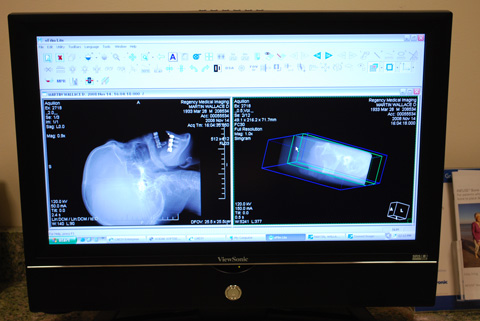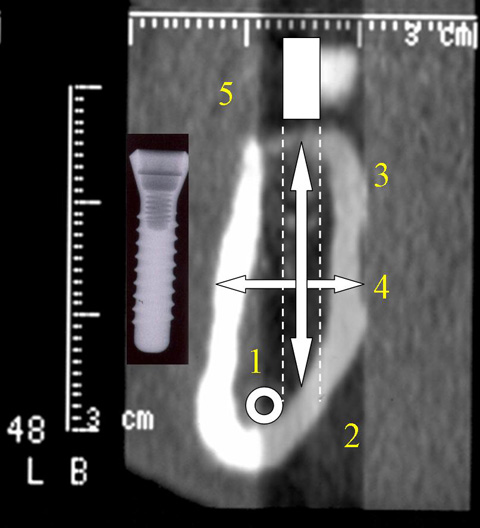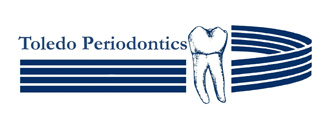The Implant Process
The Initial Consultation Appointment: This appointment will allow our office to evaluate your supportive bone structure to determine if enough bone is available to place an implant. Dental x-rays are an important part of this evaluation process, but sometimes do not provide enough information regarding bone width. Other imaging tests such as a CT scan or x-ray tomography may be used to supplement the views of your bone, jaws, nerves and sinuses. Download the Counsulting Radiologists Corporation Form from this link. These tests help the surgeon learn about the quality and quantity of bone in your mouth. Your gums will also be carefully examined for signs of disease, and a thorough health history will be taken to screen for medical conditions that would interfere with the success of your implant surgery.
For Toledo Periodontics surgical guide protocols, please click here.

A surgical guide will be fabricate to insure an optimal placement of the implant, sometimes further analysis to the quantity and the quality of the bone is examined using CAT scan images which provides;
- Vital Anatomical Structures
- Anatomical structures
- Bone length.
- Bone width.
- Surgical alignment of the surgical guide.
A step by step fabrication to the surgical guide could be viewed at Dr. Scott E. Keith’s web site www.sfbaydental.com or www.dentistry4tomorrow.com

The Initial Surgical Appointment: At this appointment it is important to tell our staff if you are taking any new medications or have had any changes in your health since your consultation appointment. Please take any prescribed medications prior to the appointment as directed. Wear comfortable clothing, and relax! You are in excellent hands. Your jaw will be numbed just before surgery. If you have any concerns regarding dental anesthesia, please view “anesthesia” under our “Patient Information” tab. A small incision is made in the gum to expose the jawbone, and a hole is precisely drilled into the jawbone to exactly match the size of the implant. The implant is then gently twisted into position, and the incision is closed with a few stitches.
Healing: Your gum in the surgical area will heal very quickly, within 1-2 weeks. A short follow-up appointment is made one to two weeks after the implant placement surgery to remove stitches (if necessary) and evaluate your healing. It is important during this initial healing period to finish all prescription medications and clean the surgical site as instructed, using the prescription mouthrinse. You may wish to eat soft foods for the first few days after surgery, and only wear any removable appliances such as partial dentures, dentures, retainers or mouthguards if instructed to do so. Generally, it is advised to NOT chew in the area of the healing implant for the first day or two after surgery. Our patients report MINIMAL discomfort, if any, after surgery and during this healing phase.
Healing Abutments and Final Abutments: If a second surgery is indicated to place an abutment (connecting piece to join the implant to the artificial tooth), this will be scheduled sometime in the next 2-6 months, depending on the location of the implant and your healing time. Again, the area will be numbed and a small incision will be made into the gum tissue that has grown over the implant. The abutment, a small extension placed to bring the implant above the gumline, is placed on the implant. The gum is allowed to heal around the abutment for 1-2 weeks. This minor surgery is quick and simple, as your bone has fused with the implant by this time. Often, no stitches are necessary for this procedure.
Placement of the final crown or artificial tooth: As soon as the gums around the abutment have healed, your general dentist can take impressions to allow the dental laboratory to custom make a crown or artificial tooth that beautifully matches your natural teeth. This crown is then placed on the abutment and your bite is adjusted to be stable and comfortable. Usually no anesthetic is needed for either the impressions or the final crown placement. You will be given all of the necessary instruction and aids to help you keep your implant healthy, and your implant will be closely monitored by your general dentist and the periodontist. Your implant is now complete and you many enjoy speaking, smiling and chewing with confidence.
Multiple implant placement for fixed bridges or full dentures: the implant placement procedure for stabilization of fixed bridgework or dentures is exactly the same as for a single tooth, except multiple implants are placed. Often times a temporary prosthesis (denture) is made to be worn during the healing phase of treatment. While this prosthesis can usually be worn immediately after surgery, you may be instructed to avoid chewing with it for the first few days after surgery to protect the healing implants. Once healing is complete and your bone has fused with the implants, a final fixed bridge or denture can be made by your general dentist. A few appointments may be necessary to adjust your bite for comfort and stability, but you will quickly enjoy speaking, chewing and smiling with confidence.
